Outline:
1. Questions from Comments
2. Analysis of our Neural Network
3. Concluding Remarks
4. Future Plans
1. Questions from Comments:
In this section, we will be answering the questions we received from our last post.
- It seems that not every neuron is connected to EVERY other neuron since there are different connection pattern.
- When you say an energy of “-5000″ what are your units/reference point? I am still wondering how and why the Monte Carlo Method works and how the energy state is so low for ordered systems. This may be unrelated and somewhat random, however, why is it that entropy (disorder) in chemistry always increases and is actually considered a lower state of energy?
Every neuron in our neural network is connected to one another. The results of their connection can be found within the j-matrix; each pattern has it’s own j-matrix. When we store multiple patterns in one system, separate J matrices are created for each pattern, but the J matrix that is used (J_total) is the element-wise average of the separate J matrices. So, for each neural network there is only one J matrix, which describes the connections between each neuron and every other neuron.
When a pattern is greatly distorted it takes more energy to return it back to the desired pattern. However, entropy states that the greater the disorder the lower the state of energy. Our neural network is an artificial system that has no relations to entropy. Our energy state for ordered patterns is less than that of disordered patterns because that is the way our code is designed. Furthermore, our j-matrix is designed so that when we calculate the energy of stored patterns it gives us a large negative value for energy. However, when we calculate the energy of disordered patterns it gives us energies close to zero. The energy calculated in our neural network does not have units; it’s similar to intensity where we are just concerned with the relative energy between the neurons. The Monte Carlo method simply goes through a distorted pattern and determines whether or not a neuron needs to be flipped. This decision is based on the input of one neuron from the summation of the inputs of the other neurons within the neural network.
2. Analysis of our Neural Network:
Since our last post we have created neural networks with a larger number of patterns stored, in an attempt to study the system as it begins to fail correct memory recall. The way we accomplished this was by building systems with more letters as stored patterns. We had a system which stored A-C, one which stored A-D, and one that had A-F and also a lowercase letter a. Pictures of all of the letters we used as stored patterns are shown below.
Below are the 7 stored patterns within our neural network.
These systems (and links to their codes) are discussed below, but first a little background on the storage of many patterns in neural networks.
As explained in our previous posts, storing more patterns in a neural network causes these patterns to become more unstable: if you think of the energy energy landscape picture from our last post, the minima associated with each pattern become shallower the more patterns that are stored. This occurs because of the averaging of all the J matrices that correspond to the individual patterns that we want to store: each new pattern distorts parts of the other patterns. This can be seen visually in the pictures of the J matrices in our last post; the combination of A and B is much more complicated than A and B on their own.
Our textbook (Giordano and Nakanishi) talks about the limitations of how many patterns can be stored in a neural network. The main obstacles are that 1. any patterns that are too close to each other will likely interfere, and 2. there is a theoretical limit at which the system changes and all patterns become unstable.
For 1., think of the energy landscape again, as well as the letters we use. The minima for the letters B and D will be relatively close together on the energy landscape because they are relatively similar patterns, and thus their troughs will likely merge a bit and may produce patterns somewhere between the two. We run into exactly this problem with our A-D code, which often works for A and C (as long as they are not too distorted, usually less than 0.3 or so), but which usually returns a pattern somewhere between B and D when given distorted inputs of B or D.
If you want to try this out for yourself, use the code below.
Link to Code: Stored Patterns A-D
The theoretical limit of the number of patterns that can be stored is given in the text as ~0.13N (in our case, 13 patterns). Our neural networks begin to function very poorly once we store 7 patterns (A, B, C, D, E, F, a); beyond simply confusing the letters that are similar, nearly all inputs lead to the same answer, a strange hybrid of letters (mainly F and B it seems), shown below.
This code actually does work for some inputs (if given an A distorted by 0.1 or less, successful recall of the letter A is usually achieved). However, nearly all inputs, even those unlike any other pattern (such as the lowercase a) give the same jumbled result seen above. This is likely a combination of the two effects mentioned above: many patterns here are similar to each other, and the number of patterns has significantly lessened the deepness of the minima associated with each pattern, leading to more instability across all of the stored patterns. Ideas for how to get real systems closer to this theoretical limit of 0.13N are discussed in Future Plans.
Try this out for yourself with code below.
Link to Code: Stored Patterns A-F + a
We were able to create a very functional neural network that stored three patterns, A-C, which avoided almost all of the problems of having patterns too similar to one another and having so many patterns that the energy landscape minima become too shallow. The link to this code is below.
Link to Code: Stored Patterns A-C
3. Concluding Remarks:
We started this project in wanting to answer these questions:
- How far away initial inputs can be from stored patterns while maintaining successful recall.
- How many patterns can be stored in the neural network. The book discusses the maximums associated with this type of neural network, but we will investigate why this limit exists, as well as what kinds of behaviors change around this limit.
- How long (how many Monte Carlo iterations) recall of stored patterns takes.
During the time spent on this project we were able to answer the above questions. However, we also ran into several unexpected problems and results. We found that the most we could distort a pattern is by roughly flipping 45% of the pattern, in order for our code to still work. Patterns that were distorted by 50% no longer worked and the image output was not recognizable. These numbers are based on a neural network with just three patterns: A, B, and C.
Several patterns can be stored in the neural network, however in order to have a neural network that works, we could only store 3 of our 7 patterns. This is so because after C, the letters become very similar to one another; for instance B and D or E and F. With these similarities the neural network produces output patterns that are half way between the similar letters, instead of one letter. If we had 7 patterns that were all drastically different from one another, we believe that our neural network would work.
The amount of Monte Carlo iterations is highly dependent on the amount of patterns stored in our neural network and by how distorted a pattern is. In our code we set a limit of 1000 iterations where the program stops if it is taking 1000 Monte Carlo sweeps to achieve the desired pattern. If a program takes 1000 iterations it means that the desired pattern we want is not going to be produced. This is where you get patterns that are incomplete or half way between two letters. When our neural network was successful it only took 1 Monte Carlo iteration to give us the desired pattern. Below is a picture of a distorted B and the output result after 1000 iterations, which is a pattern between B and D. As you can see the distorted B is very close to the letter B, however because this neural network has D stored as a pattern, it can not make up it’s mind as to which letter to display.
4. Future Plans:
One of the main things we would want to do next is to create a neural network with more patterns, approaching that theoretical limit of 0.13N. The best way to do this is likely with patterns that are more orthogonal than the letter patterns we used in this project. This would be easiest to accomplish with very simple but drastically different patterns, such as vertical lines or circles in different positions. With these new patterns, we would be able to uncover much more about our neural network than we can now with storing letter patterns that are very similar to one another.
Another objective we would want to tackle is how the size of the neural network affects its function. Specifically, I wonder if we used the same 7 patterns (letters A-F and lowercase a) but in a neural network that was 15×15 neurons (or even bigger), would we be able to get successful recall of the lowercase a, as we were unable to with our current 10×10 size network? More neurons (more importantly, a bigger J matrix) should be able to handle more patterns before the energy landscape minima become too shallow, so this should work, in theory. Testing this would provide us more insight into the limitations on the number of patterns that can be stored in a neural network.

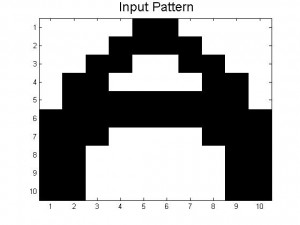
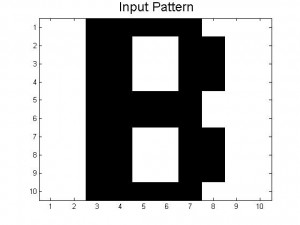
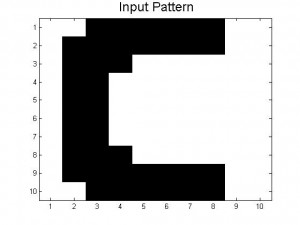

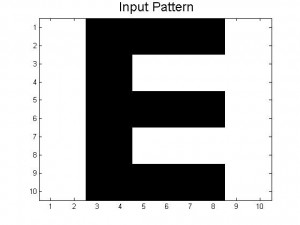
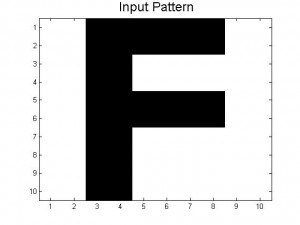
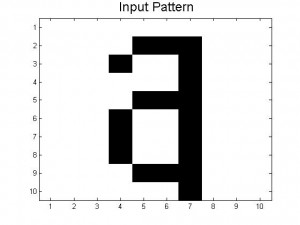
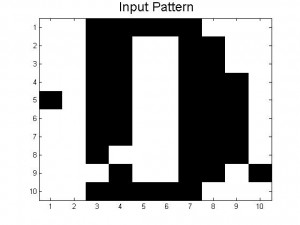
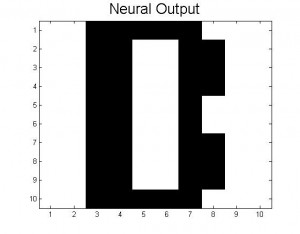

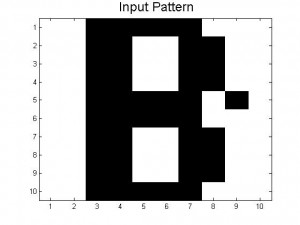

This project was very intriguing, and I am now extremely interested in how the Ising model and Monte Carlo method can be used in studying pattern recognition. I had a lot of fun running your code, overall great project.
First off, I want to say that your project is extremely intriguing and that you definitely accomplished the goals listed in the proposal. From your posts it is clear that the Monte Carlo method is a very powerful method with applications reaching far beyond physics.
You did a very good job explaining the that each neuron has an initial condition of +1 or -1 similar to an electron being either being spin up or spin down, and the use of the Ising Model and Monte Carlo method in ferromagnetic alignments is easily applied to this situation. This physically can be interpreted in this situation as a neuron either firing or being dormant. You did well in the explanation of the input signal that is a N x N matrix and this results in a J matrix that that helps store the pattern. The J matrix is N2 by N2, which makes sense from your code because of the two for loops. In addition you did a nice job explaining that the J matrix stores the connections between neurons. In your code it is a little unclear how exactly each neuron is connected, which could have been further explained by adding more comments. Despite not having many comments, the few in the code were extremely pertinent. Running your code was extremely fun, and I really enjoyed being able to choose the neural output and input pattern. The flipping condition is quite basic and easy to understand; on the most basic level it makes sure that the distorted input pattern becomes one of the stored patterns through via the Ising model.
I thought it was very interesting that the Monte Carlo method results in the total energy dropping and when the program reaches a minimum, it enters an energy “trap” in which further sweeps do not change the image. My intuition tells me that the energy of the system would stay constant, but evidently this is not true. The more patterns stored the more unstable the output pattern, which logically makes sense because it becomes harder for the program to differentiate output patterns in the J matrix, where the stored patterns are allocated. With only a couple of runs of the code this is evident when the E and F output look distorted. How did you find the theoretical limit of the number of stored patterns? It would be interesting if you could include this calculation or other sources that led you to this conclusion. In addition how did you determine that at 1000+ sweeps would not produce the proper neural output?
The biggest question I had was, what does the average J matrix mean physically? If we think of the proper displaying neural output as recalling the correct memory, would the mixing of the B and D be similar to combining two memories. Or is this oversimplifying the concepts of pattern recognition in an already possibly simplified system? I think that it is possible that the average J-matrix cannot be a true average of each element inside the J-matrices because this is always going to create an unstable neural output. I think that a great next step would be determining whether you would run into similar neural output issues with multiple stored patterns if the input matrix was not 10 x 10, but smaller or larger.
Finally, what do other sources have to say about modeling neural outputs with computers? Have other people run into similar issues that you experienced? This would have been nice to investigate and explain to the reader that others are experiencing similar issues.
N refers to the size of the neural network in question, size being quantified by the total number of neurons. In our project, N was always 100, so the theoretical limit of 0.13N mentioned in this post just refers to a number of patterns, in our case 0.13(100) = 13 patterns. This number is the theoretical limit of patterns that can be stored in a neural network while the network retains its functionality. Trying to store a larger number of patterns in the network will result in failed recall for all patterns, regardless of the input (according to Giordano and Nakanishi).
I hope that answers your question.
Tewa and Brain,
First off I must commend you guys for the complexity and comprehensiveness of your project. To gain a better understand of this project, I read through all the previous posts you had posted (abstract, outline, preliminary results. etc) and found that you had thoroughly explained most, it not all, of the project and its many different sections. You initially had goals where you sought out to investigate how to create a neural network model, how well it retrieved stored patterns depending on differing input patterns, the limitations on how many patterns can be stored and how well the system functioned when parts of the memory are damaged. You had set up flow charts, and addressed all questions that were given immediately to clear up any ambiguity about the project.
You were able to provide a really nice outline on the basics of neural networks and the methods needed to investigate your goals. Although I have no idea what an Ising model, you guys explained it simply enough that I was able to understand that the neural network model is the Ising model with the temperature parameter set to zero, so that the neurons never flip randomly on their own but only in response to their connections with other neurons. Utilizing the Monte Carlo was also done well. Having it set up to decide which neurons to flip in order to change the input pattern into one of the patterns that have been stored in the neural network was genius. If I read it correctly, the Monte Carlo sweeps through every neuron, decides if it should be flipped based on certain flipping rules, flips if necessary, and then goes onto the next neuron, correct?
Running the codes through MatLAB was also easy enough. Although there were not that many comments, the comments posted were concise enough that it was not necessary to ask for further elaboration. For the final conclusion I could see how storing more patterns could overload the processing of the “neural network.” What I don’t understand is how you found the theoretical limitation of the number of patterns stored. Is this based on the size of the neural network (the J-matrix)? What does the N represent? You also brought up a point that I was thinking about from the beginning, where if you had many patterns that were all drastically different from one another, the neural network would then be able to accurately resemble previously stored patterns, correct?
In the end, this was definitely a computationally heavy project. Explanations were there, concepts were described and goals were reached. The flowchart was also a nice touch and the figures helped me picture exactly what was going on from the stored matrix, to the interaction matrix and the final output matrix. A job well done.
Alex Molina
I am wondering what the unit ‘N’ is on your theoretical limit. How do you explain using that unit?